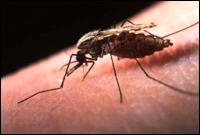health
-
WSJ, USA Today highlight dangers
The Wall Street Journal astounded many in the green community last week when it launched a series on toxic chemicals with an in-depth page A1 story on endocrine disruptors, which, even in teeny-tiny amounts, muck up the functioning of human bodies, according to an ever-growing body of scientific studies.
Now USA Today is getting in on the game with "Are our products our enemy?" Here, reporter Elizabeth Weise's delightfully melodramatic lead:
Like the glint of a knife in the dark, a laboratory accident in 1998 helped scientists realize that some chemicals commonly used to make life more convenient can be health hazards.
Since what they still call "the disaster" in geneticist Pat Hunt's lab, more scientists have come to suspect that, even in tiny amounts, some of the chemicals that keep our food fresh, our hair stylish, our floors shiny and our fabrics stain-free might be confusing our hormone systems and derailing fetal development.
From what I can discern, there's not much real, breaking news in these stories; rather, the real, breaking news is these stories. Which news outlet will jump on board next?
-
Toxic babies
You know, nothing warms the cockles of a father-to-be's heart like a study showing that babies in the womb are awash in toxic chemicals.
We are abusing our children, all of us, before they are even born. Lovely.
-
An interview with doomsaying author James Howard Kunstler
James Howard Kunstler.“Check all of your assumptions at the door,” James Howard Kunstler advises reporters before he commences an interview. “Don’t assume that anything you think about the way we live today is going to be the same 10, five, even three years from now.” The author of the new book The Long Emergency: Surviving […]
-
Eco-label watchdog Urvashi Rangan answers questions
Urvashi Rangan. What work do you do? I’m an environmental-health scientist and policy analyst at Consumers Union. I also manage two public-education websites. Consumers Union also publishes Consumer Reports magazine, and I do dip into the testing and publishing side of the organization, but my work is mostly on the public service, technical policy, and […]
-
Doctors, vets, and scientists unite in brave new world of conservation medicine
Mosquitoes have Hawaii all abuzz. Photo: WHO/TDR/Stammers. On an airport runway in Hawaii last fall, a sparrow nearly became a canary. State officials testing captured birds got one positive result for the West Nile virus, which had yet to arrive from the mainland. Hawaii and Alaska remain the only states in the U.S. that haven’t […]
-
How toxic is your breast milk?
A nice treatment of this topic in today's New York Times Magazine, from Florence Williams.
When we nurse our babies, we feed them not only the fats, sugars and proteins that fire their immune systems, metabolisms and cerebral synapses. We also feed them, albeit in minuscule amounts, paint thinners, dry-cleaning fluids, wood preservatives, toilet deodorizers, cosmetic additives, gasoline byproducts, rocket fuel, termite poisons, fungicides and flame retardants.
If, as Cicero said, your face tells the story of your mind, your breast milk tells the decades-old story of your diet, your neighborhood and, increasingly, your household decor. Your old shag-carpet padding? It's there. That cool blue paint in your pantry? There. The chemical cloud your landlord used to kill cockroaches? There. Ditto, the mercury in last week's sushi, the benzene from your gas station, the preservative parabens from your face cream, the chromium from your neighborhood smokestack.
Williams very effectively uses the personal angle of breastfeeding her daughter to approach the larger topic of toxic substances in our environment, brominated flame retardants (PBDEs) in particular. Yes, it's a highly approachable article on flame retardants -- imagine that.
-
Umbra on the health/environment dividing line
Yowza. A few weeks back, in response to a question from a reader named Cassandra about the relative merits of soy milk, I asked your opinion on the dividing line between health and environmental concerns. Cassandra wanted to know if she could continue eating soy, which she considered an environmentally sound choice, without increasing her […]
-
Umbra on the eco-relevance of health concerns
Dear Umbra, As a practicing vegan for quite some time now, I take pride in my knowledge of nutrition and my ability to enrich my body through a varied diet with all the essentials. For the past five years or so, I have heavily relied on soy products for protein and other nutrients. Recently, however, […]
-
Advice on antioxidant-rich foods and why they cost so much
Dear Umbra, Antioxidant foods are “the thing” right now, and I would love to be able to eat as many as I need. However, they are usually the most expensive fruits and vegetables. Would it not make sense for farmers or producers to grow these products in greater volume, so we could all afford them […]
